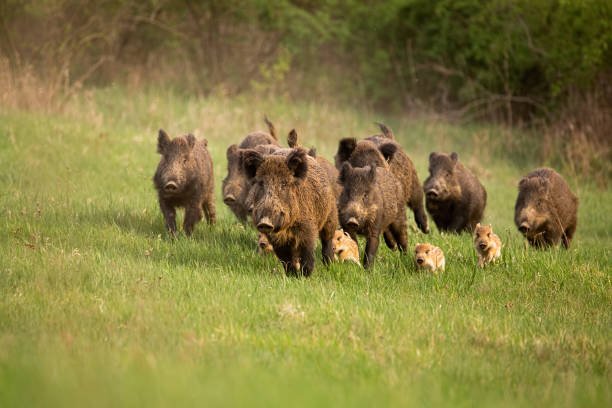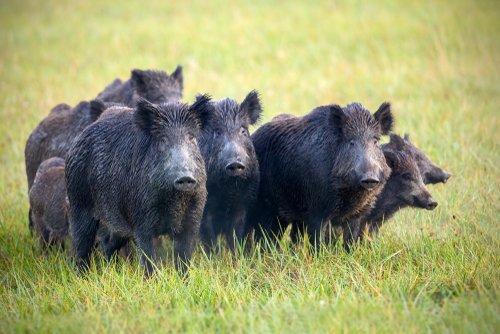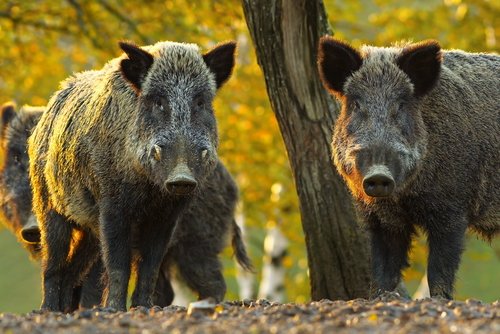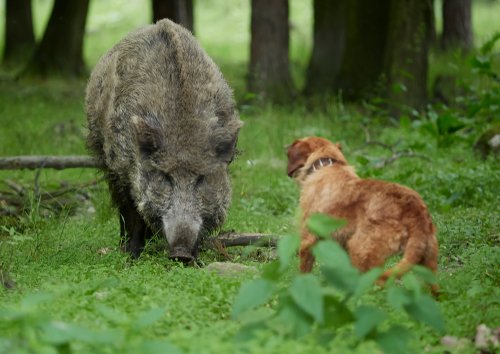Wildlife Encounters in Hog Hunting: Increase You Awareness Now
Hog hunting has gained tremendous popularity among outdoor enthusiasts and thrill-seekers alike. It offers a unique opportunity to immerse oneself in nature while engaging in a thrilling pursuit. In this blog we will delve into wildlife encounters in hog hunting in depth.
This age-old activity traces back to our ancestors, who relied on it for sustenance. Today, however, it has evolved into something more than just obtaining food – it has become a cherished wildlife encounter that reconnects us with our primal instincts.
Balancing Nature’s Scales: The Crucial Role of Hog Population Control
The significance of hog hunting extends beyond personal enjoyment and adventure—it plays a vital role in maintaining ecosystem balance. While wild hogs may seem harmless initially, their unchecked population growth wreaks havoc on native habitats and agricultural lands. Wild hogs possess remarkable adaptability and reproductive capabilities, allowing them to multiply under favorable conditions rapidly.
Unfortunately, these intelligent creatures have no natural predators in many regions where they have been introduced or escaped captivity. Consequently, their numbers surge uncontrollably, leading to devastating consequences for both flora and fauna.
When left uncontrolled, hogs can cause significant damage by uprooting crops, damaging fences, and eroding soil through relentless rooting activities. Moreover, they outcompete native wildlife for resources such as food and water sources while also impacting delicate ecosystems by altering vegetation patterns.
Effective population control measures are essential to mitigate these ecological impacts and offset economic losses faced by farmers due to hog-inflicted damages.
Hog hunting is an indispensable tool in achieving this objective, curbing their numbers and preserving the delicate balance of our natural ecosystems. Stay tuned for the next section, where we will explore the fascinating world of wild hogs and their physical characteristics and behavior.
Description of Wild Hogs’ Physical Characteristics and Behavior
Wild hogs, also known as feral pigs or wild boars, are robust creatures with a distinctive appearance that sets them apart from their domesticated counterparts. These formidable animals can vary in size and weight depending on their age and gender.
Adult wild hogs typically weigh between 100 and 300 pounds but can grow even larger in certain regions. Their bodies are covered in coarse, bristly hair, often exhibiting shades of brown or black, with some boasting gray or reddish fur patches.
One cannot help but notice the prominent tusks protruding from their lower jaw, reaching formidable lengths up to several inches. These razor-sharp tusks serve a dual purpose – as tools for digging up vegetation or rooting for food and as defense mechanisms against predators or rivals.
Additionally, wild hogs possess a keen sense of smell that aids them in locating food sources from great distances. In terms of behavior, wild hogs are highly adaptable creatures with an impressive ability to survive in various habitats.
They display diurnal (active during the day) and nocturnal (active during the night) tendencies depending on factors such as seasonality and predation pressure. Their omnivorous diet consists of roots, tubers, nuts, fruits, insects, small mammals, and even carrion when available – making them opportunistic feeders capable of raiding crops or damaging native plant communities.
Discussion on their Destructive Impact on Crops and Native Habitats
While wild hogs possess fascinating physical attributes and resilient behavior traits that enable survival in diverse environments, they pose significant threats to crops and native habitats. These voracious creatures have an uncanny ability to decimate entire fields within hours while foraging for food.
Their rooting behavior is particularly destructive; using their snouts, they extensively uproot soil, rip apart vegetation, and damage agricultural lands. This can result in substantial economic losses for farmers who rely on these crops for their livelihood.
Moreover, wild hogs’ foraging disrupts the delicate balance of native habitats by altering ecosystems and negatively impacting other plant and animal species that depend on these areas. The consequences of their destructive habits extend beyond crop damage.
Wild hogs are known carriers of diseases such as brucellosis and pseudorabies, which can have severe implications for livestock and humans. Their prolific breeding rates also contribute to exponential population growth, exacerbating the challenges of managing their impact on agricultural and natural landscapes.
Understanding wild hogs’ physical characteristics and behavior is essential in comprehending their impact on crops and native habitats. Their robust physique, including sharp tusks and keen sense of smell, enables them to survive in various environments.
However, this adaptability comes at a cost, as they can wreak havoc on agricultural lands through destructive rooting behavior. Recognizing the challenges posed by feral pigs is crucial for implementing effective management strategies to mitigate their harmful effects on both human livelihoods and fragile ecosystems.
Popular Methods of Hog Hunting
Traditional hunting with firearms and bows
When it comes to hog hunting, traditional methods involving firearms and bows have been tried and tested over the years. Hunters often opt for high-powered rifles or shotguns to take down hogs from afar. The popular choices include .308 Winchester, .30-06 Springfield, or even the mighty .45-70 Government for those who prefer a hard-hitting approach.
These firearms offer the power to penetrate hog hide and ensure a clean kill. On the other hand, bowhunters find great satisfaction in stalking hogs silently and getting up close and personal for that perfect shot.
Compound bows are commonly used due to their power and accuracy. Additionally, crossbows provide another option, especially for hunters who might have difficulty drawing back a compound bow.
Skilled archers might also choose traditional recurve or longbows for an added challenge. Bowhunting techniques such as spot-and-stalk or tree stand setups can be effective when executed precisely.
Nighttime hunting with thermal imaging technology
Nighttime hog hunting has gained popularity in recent years with advancements in thermal imaging technology. This cutting-edge gear lets hunters detect heat signatures emitted by hogs even in complete darkness. Thermal scopes, handheld devices, or clip-on attachments enhance visibility at night, making it easier to locate hogs when they are most active.
The advantages of nighttime hunting are undeniable—hogs tend to be more active during cooler hours, while other wildlife may also be less active. Furthermore, using thermal imaging enables hunters to identify the size of a group before initiating an approach without spooking them off prematurely.
However, nighttime hog hunting does come with its challenges, too. Dense vegetation can make it difficult to spot hogs through thermal imaging alone since they may blend into their surroundings easily.
Additionally, the darkness can make it harder to judge distances accurately, increasing the possibility of missed shots. Therefore, hunters must exercise caution, adapt their hunting strategies, and continually refine their skills to maximize success during nighttime encounters.
Hog hunting offers a range of methods and techniques for enthusiasts to enjoy thrilling wildlife encounters. Whether opting for traditional firearms or honing archery skills with a bow, hunters can experience the excitement and challenges of stalking hogs.
Nighttime hunting with thermal imaging technology adds another dimension to the pursuit, providing an advantage when darkness falls. By exploring these popular methods and adapting to different situations, hunters can make their hog hunting experiences unforgettable.
Wildlife Encounters during Hog Hunting
Interaction with Other Animals while Tracking Hogs
When venturing into the wild for a hunting expedition, one can expect more than a face-to-face encounter with the elusive hogs. The dense forests and open fields that serve as their preferred habitats also provide a chance to witness the beauty of other wild creatures in their natural environment. As you cautiously navigate the undergrowth, your senses become attuned to the subtle sounds and movements around you.
Suddenly, there it is – a graceful deer grazing peacefully by a patch of wildflowers. A flock of turkeys may also strut nearby, their iridescent feathers glimmering under dappled sunlight.
These unexpected animal encounters add an element of surprise and admiration to your hunting experience. Observing these creatures in their undisturbed state can deepen your appreciation for the interconnectedness of all life forms within the ecosystem.
It’s fascinating to witness how different species coexist harmoniously, each playing its unique role in maintaining ecological balance. Such encounters remind us that hog hunting is not solely about pursuing hogs but immersing ourselves in nature’s grand tapestry.
Unexpected Encounters with Predators During Hunts
Hunting hogs can sometimes lead to thrilling and extraordinary moments when hunters cross paths with predators lurking in the same wilderness. Picture this: you are stealthily tracking down a group of hogs when suddenly, out from behind a cluster of trees emerges a coyote, its eyes gleaming with primal intensity.
In rare instances, even larger predators like bobcats or bears may appear during these hunts, adding an extra layer of exhilaration to an already captivating experience. These predator encounters are adrenaline-inducing and remind us that nature operates on its terms, independent from our human desires and pursuits.
Witnessing the predator-prey dynamics firsthand ignites a deeper understanding of the intricate web of life. The presence of these predators reminds us that while hunting hogs is important for population control, respecting and acknowledging the coexistence of all species within their natural habitat is essential.
Wildlife encounters during hog hunting offer a delightful surprise by bringing hunters face-to-face with various species thriving in the same ecosystem. From observing deer grazing peacefully to encountering predators like coyotes or even bears, these experiences provide a captivating glimpse into nature’s intricate tapestry.
They remind us that hog hunting goes beyond pursuing hogs; it allows hunters to immerse themselves in the interconnectedness and profound beauty of the natural world. So, as you embark on your next hog-hunting adventure, keep your senses sharp and open yourself up to the unexpected encounters that await you amidst the captivating wilderness.
Specialized Techniques for Hog Hunting Wildlife Encounters
Stalking techniques to get closer to wildlife without alarming them.
Regarding wildlife encounters during hog hunting, mastering stalking techniques is vital. The goal is to observe animals up close without causing alarm.
To achieve this, one must move quietly through the woods, aware of every step taken. Slow and deliberate movements are essential, with an emphasis on avoiding breaking twigs or rustling leaves that could alert nearby wildlife.
Experienced hunters employ several strategies while stalking animals. They carefully choose their path, utilizing natural cover like trees and rocks to camouflage their movement.
Pacing themselves and taking breaks when needed helps maintain focus and reduces fatigue that could lead to unnecessary noise. Using these stealthy tactics, hunters increase their chances of encountering various wildlife species during hog-hunting expeditions.
Tips for moving quietly through the woods to observe animals up close.
Moving silently through the woods requires a combination of skill and awareness. Hunters should choose footwear with soft soles that won’t produce loud footsteps on dry leaves or crackle twigs underfoot. Walking heel-to-toe allows for a more controlled step by distributing weight evenly, minimizing noise generation.
To observe animals up close without alarming them, it’s also crucial to be mindful of body movements. Hunters should avoid sudden gestures or jerky motions that might startle nearby wildlife.
Instead, they adopt slow and deliberate motions when turning their heads or shifting positions. The art of stealth extends beyond footwork; clothing plays a pivotal role in remaining undetected by sensitive animal senses such as sight and smell.
Importance of camouflage clothing and scent control.
Camouflage clothing should be an integral part of any hunter’s equipment arsenal when aiming for successful wildlife encounters during hog hunting trips. The purpose of effective camouflage is not to become invisible but to blend seamlessly into the natural surroundings. Camouflage patterns mimic the colors and textures of the environment, making it more difficult for wildlife to detect human presence.
Additionally, scent control is essential in minimizing one’s odor signature. Wild animals possess an acute sense of smell, allowing them to detect faint human scents from a considerable distance.
Hunters employ various scent control measures, such as scent-neutralizing sprays or washing clothing with specialized detergents that eliminate human odors. By combining camouflage clothing with diligent scent control, hunters increase their chances of getting closer to wildlife undetected, leading to more rewarding and exhilarating encounters during their hog-hunting adventures.
Baiting strategies to attract both hogs and other wildlife.
Baiting is a popular technique used in hog hunting to attract hogs and other wildlife species. By setting up bait stations strategically, hunters can lure in animals from miles away, providing opportunities for fascinating encounters.
Setting up a bait station requires careful consideration of location and timing. Choosing an area frequented by hogs and other animals is important while ensuring it aligns with local regulations.
Common bait options include corn or specialized feed designed explicitly for attracting hogs. A successful bait station attracts hogs and is a magnet for wildlife species like deer and turkeys.
Observing these interactions can provide insight into the dynamic relationships between different creatures within the ecosystem. When properly executed, baiting strategies can heighten the excitement of hog hunting by presenting unexpected animal encounters throughout the hunt.

Conclusion
Wildlife encounters during hog hunting allow enthusiasts to fully immerse themselves in nature’s wonders while pursuing their quarry. Through specialized techniques such as stalking silently through wooded terrain, utilizing camouflage clothing, and careful scent control measures, hunters increase their chances of discreetly encountering diverse wildlife species. Additionally, baiting strategies attract hogs and entice other animals to the hunting area, resulting in fascinating interactions and unexpected encounters.
These encounters provide a deeper understanding of the intricate ecological relationships between different creatures and remind us of the interconnectedness of all living beings. Whether observing deer as they graze in harmony with hogs or witnessing a predator silently lurking nearby, these moments enrich our experiences as hunters.
In this pursuit, we not only contribute to population control efforts necessary for ecosystem balance but also gain a profound appreciation for the beauty and diversity found in the natural world. The encounters during hog hunting remind us that our actions can contribute positively to wildlife conservation efforts while fostering a deep reverence for nature’s wonders.





